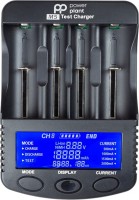Power Plant PP-M5 (AA620074)
 | Outdated Product Charging slots: 4; Supported types: Ni-Cd; Ni-Mh; Li-Ion; IMR; Size: AAAA; AAA; AA; C; D; 10440; 14500; 16340 (CR123); 17335; 17500; 17670; 18490; 18650; 22650; 26500; 26650; Operation indicator: display; Min. charge current (mA): 500; Max. charge current (mA): 2000; Charge current, all channels (mA): 1000 |
Power Plant PP-M5 | |||||||||||||||||||||||||||||||||||||||||||||||||||||||||||
|
| ||||||||||||||||||||||||||||||||||||||||||||||||||||||||||
Always clarify the specifications and configuration of the product with the online store manager before purchasing.
Catalog Power Plant 2025 - new arrivals, bestsellers, and the most relevant models Power Plant.
Batteries, chargers for them and surge protectors are the main field of activity of the Ukrainian company Power Plant. Its product portfolio includes the advanced PP-M5 battery charger. Why is he so good? Let's figure it out.
Separate power channels
The model has four slots for cylindrical batteries, whether they are the usual “finger-type” batteries or plump “barrels” of type D. Each of the “charger” cells is a separate power channel for which individual operating modes are set and different values of the charging current are set . The discharge current of the Power Plant PP-M5 is fixed at 500 mA.
Advanced functionality
With the simultaneous use of all slots, the charging current for a single cell is selected between 500 or 1000 mAh, with three batteries it is possible to increase it to 1500 mAh per cell, and with two batteries — up to 2000 mAh. The functionality of the device provides for discharging and charging batteries, testing their capacity and internal resistance. Moreover, together with elements like Li-Ion, the “charger” turns into a kind of power bank — third-party gadgets are charged through the USB port on its board.
Info display
An information display with a blue backlight is spread out at the bottom of the charger case. The screen is used to display detailed information about the process of working with batteries: it shows the selected mode, percentage of charge, battery type, voltage, charge or discharge current, resistance, elapsed time, gained capacity. As a result, charging suitable batteries is not done blindly, but under careful supervision of the situation, coupled with the collection of detailed statistical information at all stages.












